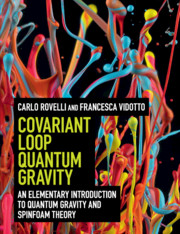13 - Final remarks
from Part IV - PHYSICAL APPLICATIONS
Published online by Cambridge University Press: 05 February 2015
Summary
We close with a short historical note on the development of the theory presented, and a few considerations on the main problems that remain open.
Brief historical note
The quantum theory of gravity presented in this book is the result of a long path to which many have contributed. We collect here a few notes about this path and a few references for the orientation of the reader. A comprehensive bibliography would be impossible.
The basic ideas are still those of John Wheeler (Wheeler 1968) and Bryce DeWitt (DeWitt 1967) concerning the state space, and those of Charles Misner (Misner 1957), Stephen Hawking (Hawking 1980), Jonathan Halliwell (Halliwell and Hawking 1985), and Jim Hartle (Hartle and Hawking 1983) concerning the sum over geometries. The theory would not have developed without Abhay Ashtekar's introduction (Ashtekar 1986) of his variables and grew out of the “loop space representation of quantum general relativity,” which was conceived in the late 1980s (Rovelli and Smolin 1988, 1990; Ashtekar et al. 1991). Graphs were introduced by Jurek Lewandowski in (Lewandowski 1994); spin networks and discretization emerged from loop quantum gravity in the 1990s (Rovelli and Smolin 1995a,b; Ashtekar and Lewandowski 1997). The geometrical picture used here derives from Bianchi et al. (2011b). The idea of using spinfoams for quantum gravity derives from the work of Hirosi Ooguri (Ooguri 1992), who generalized to four-dimensional the Boulatov model (Boulatov 1992), which in turn is a generalization to three-dimensional of the two-dimensional matrix models.
- Type
- Chapter
- Information
- Covariant Loop Quantum GravityAn Elementary Introduction to Quantum Gravity and Spinfoam Theory, pp. 235 - 239Publisher: Cambridge University PressPrint publication year: 2014



